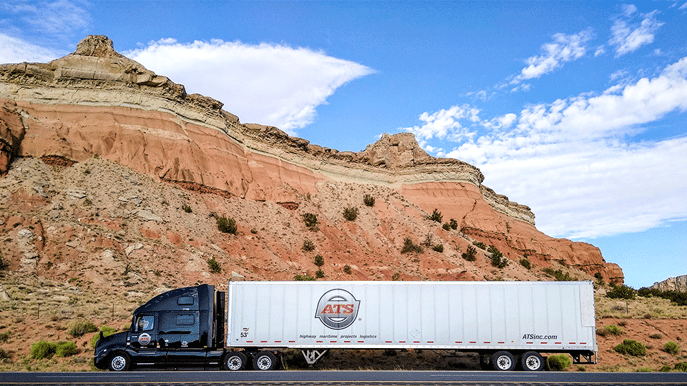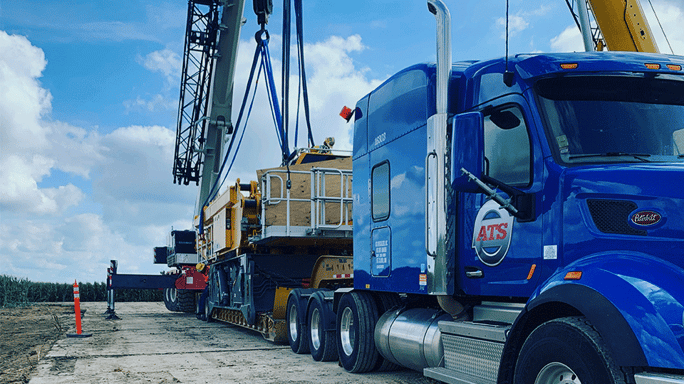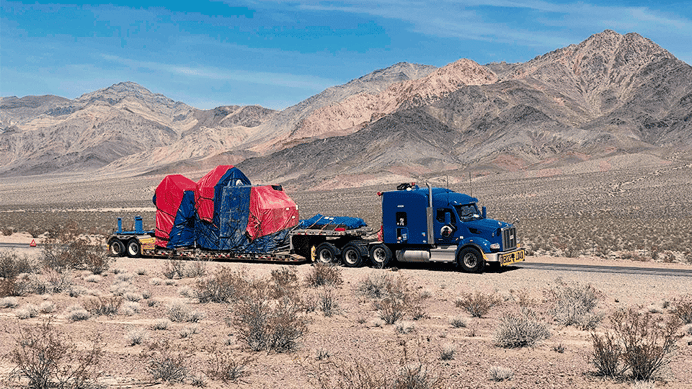- How dry van and reefer trailer capacity changes in April
- How the open-deck market shifts in April
- What to expect in oversize shipping this month
- 3 tips for successfully planning your April shipments
In the transportation industry, April is seen as a time of transition: Frost laws take effect, construction projects commence, and produce seasons kickstart.
With these spring shifts in the market, it’s important to face your shipping strategy with a fresh perspective — one that accounts for the cyclical, seasonal trends that shape the trucking industry each April.
Here at Anderson Trucking Service (ATS), we’ve been helping companies move their cargo since 1955. Over our 70 years in the industry, we’ve witnessed firsthand how taxing the first month of Q2 can be on under-prepared shippers.
We’re passionate about helping shippers achieve success every month of the year — which is why we’ve created this guide to navigating April 2025.
In this article, you’ll get an overview of what to expect during April in the transportation industry, broken down by service type. We’ve also provided our top three planning tips to help you put your best foot forward this spring. Let’s get started!
How Will Enclosed Trailer Capacity Change in April?
Dry van and reefer capacity shouldn’t be hard to find in April in most parts of the U.S., with the notable exception of regions affected by the start of the produce harvest season.
However, depending on your shipping origins and destinations, the produce harvest season may affect your ability to find an enclosed trailer in April.
Up and down both coasts and across the southern states, a wide variety of produce will soon be ready for harvest. Many dry van truckers will pivot to refrigerated (reefer) trailers to capitalize on this flurry of activity, which may impact capacity in some areas.

Temperature-controlled freight, be it cargo requiring protect-from-freeze services or perishable produce, is always moving, but reefer demand — and rates — tend to rise in the spring and summer.
Although some dry van drivers will indeed swap their trailers for reefers in regions with harvest activity, you should still expect to pay a bit more for reefer space, especially on short notice, as the demand for these trailers rises.
With the expectation of these harvest-related shifts, enclosed trailer capacity will likely be stable this month. Provided you communicate effectively with your consignees and carriers — prioritizing lead time and appointment-time flexibility along the way — it shouldn’t be difficult to execute your dry van or reefer loads this April.
Related: What Does Dry Van Shipping Cost?
How Will Open-Deck Capacity Change in April?
Shippers in the northern regions of the U.S. will find it easier to secure capacity in April, while those in warmer areas of the country will have a harder time finding a truck.
Slowly but surely, the spring thaw defrosts construction, infrastructure, and project freight activity across the nation. This uptick in open-deck hauling opportunities for drivers creates the following ripple effect:
- As the weather warms, northern markets (which may have struggled to find open-deck capacity in the winter months) will see truckers return.
- With a larger supply of trucks to pull from, shippers in these northern regions will likely enjoy lower spot rates and greater ease of securing a truck.
- In turn, shippers in southern states won’t be able to secure capacity quite as easily — at least, not for the same rates that got the job done in the winter months.
- As the supply of trucks disperses to serve the seasonally-widening pool of demand this April, southern shippers will have fewer options to choose from, which will increase spot rates.
If you have open-deck freight to move this month in a region likely to see lower capacity and higher rates this month, our best advice is to give your transportation providers plenty of lead time to secure a solution.
With the increased competition for capacity in April, the more notice — and information — you can give your open-deck provider, the better off you’ll be.
How Will Over-Dimensional (OD) Capacity Change in April?
While heavy haul trailer capacity won’t be hard to come by, the onset of frost laws in many regions will make it more difficult to move over-dimensional (OD) freight this April.
No matter the time of year, over-dimensional (OD) shipments are complex. Keeping OD cargo, and the motoring public, safe while transporting these loads takes a practiced hand and plenty of oversight.
In April, this becomes even more complicated. It’s around this time each year that frost laws — also commonly referred to as “seasonal load restrictions” — take effect in many regions that experience winter weather.
What are frost laws? Designed to prevent road damage caused by oversized and overweight loads, frost laws are regulations that dictate the per-axle weight limits for roadways.

In springtime, the weather warms enough that roads thaw during the day — only to re-freeze when temperatures drop again at night. This cycle of thawing and freezing weakens roads, so states, counties, and municipalities across the northern regions of the U.S. levy seasonal road restrictions to prevent damage from over-heavy loads.
Frost laws — especially when they aren’t planned for in advance — can become a serious issue for supply chains. Shippers who do not work with their carriers to identify and factor-in active frost law restrictions for their shipments are likely to face prolonged delays as they scramble to find a new route.
Failure to do so means facing steep fines for disregarding the regulations and endangering the integrity of the roadways.
That’s why it’s important to consult a trusted transportation provider well before executing any OD shipments this month.
The most experienced carriers will have proven methods for avoiding the impact of frost laws and can help you plan out your shipments appropriately — even if it means selecting an alternative route or “go” date.
3 Tips For Successfully Shipping Freight in April
With the information outlined above, you’re closer to getting the most from your transportation supply chain this month. To help you have the most successful April possible, here are our top three tips:
- Plan around the Easter holiday. Easter Sunday is April 20, 2025, so truck capacity will be tough to find starting around April 17 and continuing through April 21. To avoid the capacity crunch, inform your providers of any Easter Time shipping needs well in advance.
- Provide ample lead time. April marks the annual turning point when the trucking market heats up. Expect your costs to rise if you give less than 24 hours’ notice this month.
- Be as specific as possible. Without the details, it’s nearly impossible for a carrier to cover your load effectively. Give transportation providers as much information as possible as early as possible to set your April shipments up for success.
Related: Moving Freight Around a Holiday: 3 Critical Planning Tips
What shipment details should you provide in each request for capacity? Cargo type and dimensions are some of the most important shipment details to include, as are pickup and drop-off details. Shippers should be prepared to provide carriers with the following:
- Exact cargo dimensions (Height, length, width, and height)
- Exact commodity type and value
- Pallet count, if applicable
- Special equipment needs, if any.
- Pad-wraps, tarps, strap-savers, etc.
- Requested pick-up/drop-off dates
- Address of pick-up and drop-off locations, including where to park, what side of the building to enter on, etc.
These facts are what transportation companies need to safely and successfully facilitate a load. The accuracy of these details matter greatly, so be sure to double-check your measurements, counts, addresses, and any other key piece of information before sending them off to your provider.

Stay Ahead of April's Shipping Challenges
With produce season ramping up, open-deck freight demand shifting, and frost laws impacting over-dimensional shipments, strategic planning is key to keeping your freight moving efficiently this April.
By following our top tips — planning around Easter, providing ample lead time, and sharing precise shipment details — you’ll set yourself up for success this month. Ultimately, the more proactive you are, the smoother your shipping operations will be.
If you need help determining which carriers will be the right partner to help you navigate these seasonal challenges, consider downloading our Freight Carrier Selection Checklist.
This free resource provides an easy-to-follow rubric for finding providers whose transportation capabilities and experience align perfectly with your specific freight shipping needs.
Whether you’re planning on adding carriers to your network this April or merely planning for the long-term health of your transportation supply chain, this is an evergreen tool you’ll find value in all year round.





